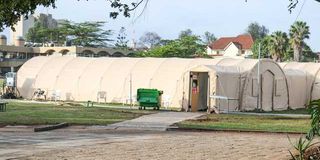Hospitals build units for more virus cases

One of the structures, believed to be a Covid-19 isolation unit, at Aga Khan University Hospital in Nairobi.
As coronavirus cases continue to rise, hospitals are developing ways of dealing with new patients.
Aga Khan Hospital developed a field unit to manage the increasing number when the Ministry of Health began announcing not less than 900 new infections daily.
Though the hospital declines to comment on the matter, the number of patients has increased exponentially in recent weeks.
The field hospital, the first of its kind in Kenya, began operating yesterday.
The total number of infections in the country has already crossed the 50,000 mark, with fatalities approaching 1,000.
Nairobi Hospital has signed an agreement with the United Nations to set up a Sh1.1 billion coronavirus treatment centre, with preference being the workers of the global organisation and their families.
The centre will be put up at Nairobi Hospital old nursing school and will complement the isolation unit at the neighbouring Silver Springs Hotel.
The 150-bed capacity centre, which will have a theatre, laboratory, radiology and physiology services will be ready in eight weeks. It will have 25 ICU and 50 HDU beds.
Rise in infections
“Apart from financing the construction of the centre, the UN will provide specialised equipment that is in short supply globally and may not be easily available in Kenya,” UN Nairobi office Director-General Zainab Hawa Bangura said.
The sustained rise in infections indicates that the country is experiencing a second Covid-19 wave, experts have said.
In infectious disease situations, waves describe the curve of an outbreak, reflecting a rise and fall in numbers.
Health experts say that there is no formal definition of a second wave, but they know it when they see it because the curve tends to rise after it has flattened.
Flattening the curve is a strategy to slow down the spread of the virus. The curve is a visual representation of the number of infected people needing health care over time. A flatter curve shows what happens if the virus spread slows down.
The same number of people may get sick, but the infections happen over a longer period, so hospitals can treat everyone.





